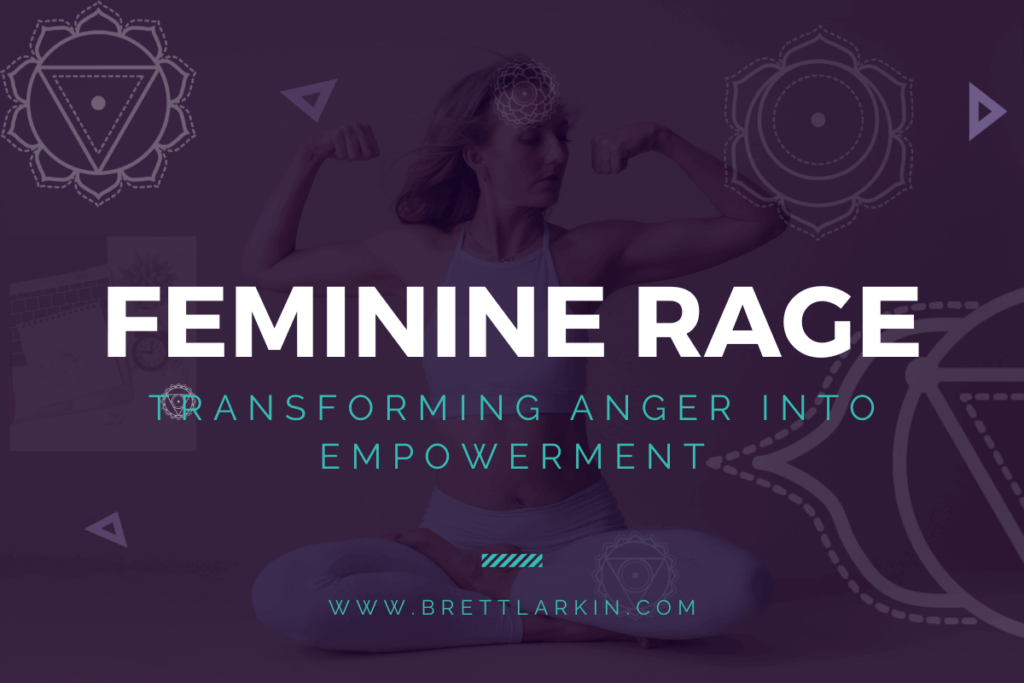Have you ever felt a surge of anger and immediately felt guilty for it, as if being an ‘angry woman’ is a label you must avoid at all costs? In a world where women’s emotions, especially anger, are often dismissed or labeled as ‘difficult’, it’s time to reframe our perspective. Feminine rage, a potent and often misunderstood emotion, is increasingly being recognized not as a flaw but as a catalyst for profound change.
This article goes deep into the essence of feminine rage, exploring its roots and how we can harness this powerful force to create positive transformations in our lives and society.
What Is Feminine Rage?
Feminine rage is the pool of women’s anger over the collective injustices women have had to face. It’s an intense feeling, not just of anger and revenge, but frustration too. It’s the reaction to looking around and seeing inequalities and stereotypes that have been around for too long.
Women will feel this strong emotion because they want things to change, to be more equal and fair. It’s about recognizing and using that powerful feeling to challenge unfair norms, demand equality, stand up and make our voices heard. It’s like a call to action, urging everyone to rethink and reshape the expectations of the women’s role.
Where Did Feminine Rage Come From?
Feminine rage has deep historical roots, stemming from centuries of systemic inequalities and suppression. Historically, women have often been relegated to secondary roles, both in societal narratives and in scientific records and literature. This marginalization is a product of patriarchal structures that have long dominated societies and culture, where women’s roles and contributions have been undervalued or overlooked.
Such systemic oppression in the patriarchy has manifested throughout history in various forms, from the denial of basic rights to more extreme acts of violence and control. This historical context is crucial in understanding the simmering anger that many women feel – an anger born not just from personal experiences but from a collective legacy of injustice, sexual assault, and rape.
In contemporary society, this dynamic persists in subtler, yet still impactful ways. Societal norms and expectations often dictate a narrow view of what it means to be a woman. Deviating from these prescribed roles can lead to challenges and judgment. Women’s anger, in particular, is often stigmatized. It seems women’s rage is either trivialized or labeled as violent or irrational, further encouraging women to suppress their emotions to fit into a patriarchal framework.
This suppression is mirrored in popular media, with television shows where female characters displaying anger are frequently portrayed as either overly emotional or unstable. Such representations reinforce the message that women should conceal their anger, a lesson that is often inadvertently passed down through generations. As a result, feminine rage becomes an internalized emotion, seen as something to be ashamed of rather than a legitimate response to injustice or harm.
This cycle of suppression and internalization has led to a collective reservoir of feminine rage. It’s a potent force that, when acknowledged and expressed healthily, can connect women to their Divine Feminine Energy. This energy, inherent in everyone, is a source of strength and balance, waiting to be tapped into and harnessed.
For those interested in exploring the historical context of this topic, Gerda Lerner’s “The Creation of Patriarchy” offers a compelling dive into the origin story of these societal power structures. Her work illuminates the historical journey that has shaped the current landscape of feminine rage.
What Does Feminine Rage Look Like?
Feminine rage, a deep-seated response to long-standing injustices and inequalities, manifests in various forms, each unique to the individual experiencing it. This female rage is not just a fleeting emotion but a powerful force that can drive significant personal and societal change.
Here are some concrete examples of how feminine rage might present itself:
- Emotional Outbursts: Sudden, intense displays of emotion, such as crying, shouting, or screaming, often in response to triggers that remind one of past injustices or current inequalities.
- Physical Symptoms: This can include tension headaches, clenched jaws, or a churning stomach, as the body physically reacts to the suppressed anger and frustration.
- Assertive Communication: Speaking up boldly and directly about issues, often in situations where one might have previously remained silent.
- Withdrawal and Isolation: Pulling away from relationships or situations that feel oppressive or triggering, as a means of self-preservation.
- Intense Advocacyv: Channeling anger into activism, passionately advocating for change, and challenging the status quo.
- Creative Expression: Using art, writing, or other forms of creativity to process and express the anger and frustration, often resulting in powerful and moving works.
- Restlessness and Agitation: A constant feeling of unease or dissatisfaction, driving one to seek change or to challenge existing conditions.
- Heightened Sensitivity: An increased awareness of and sensitivity to instances of injustice or inequality, often accompanied by a strong emotional response.
Understanding these manifestations of feminine rage is crucial in recognizing and validating the experiences of those who are grappling with these intense emotions. It’s a step towards healing and harnessing this powerful energy for positive life transformation.
Take my feminine energy quiz to get a recommended practice for balancing YOUR feminine energy 👇
How To Soothe Feminine Rage
In these transformative times, the intensity of feminine rage can sometimes feel overwhelming. It’s a powerful force, but it doesn’t have to be a burden. Here are some mindful and empowering steps to help you navigate female anger and soothe this potent emotion:
1. Mindful Breathing
Mindful breathing is a powerful tool to center yourself and manage the waves of feminine rage and sadness. It’s about finding calmness in the storm of emotions. When you focus on your breath, you give your mind a much-needed moment to break from the chaos of thoughts and feelings.
What to try:
- Try deep belly breathing: Inhale deeply through your nose, allowing your belly to rise, then exhale slowly through your mouth.
- Experiment with different breathing techniques, like the 4-7-8 method or alternate nostril breathing.
- Dedicate a few minutes each day to practice mindful breathing, especially during moments of high stress.
2. Physical Activity
Physical activity is not just about keeping fit; it’s a therapeutic way to release pent-up emotions. Engaging in exercise, especially activities you enjoy, can be a powerful outlet for your rage.
What to try:
- Incorporate activities like brisk walking, jogging, or dancing into your daily routine.
- Try yoga or Pilates, which focus on the connection between mind and body.
- Set realistic exercise goals and celebrate your achievements, no matter how small.
3. Creative Expression
Channeling your rage into creativity can transform a negative emotion of hate into something beautiful and meaningful. It’s a way to process your feelings and communicate them to the world.
What to try:
- Start a journal to express your thoughts and feelings through words.
- Explore different art forms like painting, sculpting, or crafting.
- Share your creations with others, or keep them as a personal reflection of your journey.
4. Seeking Support
Talking to someone about your feelings can be incredibly liberating. It’s important to have a support system where you feel safe and understood.
What to try:
- Reach out to a trusted friend or family member and share your experiences.
- Join support groups or communities where you can connect with others who understand what you’re going through.
- Consider professional counseling if you need a more structured support system.
5. Educational Empowerment
Understanding the roots of feminine rage can empower you to view your emotions in a broader context. Education is a tool for empowerment and change.
What to try:
- Read books and articles about women’s history and gender studies.
- Attend workshops or seminars focused on women’s issues and empowerment.
- Follow thought leaders and activists in the field of women’s rights for inspiration and education.
6. Setting Boundaries
Setting boundaries is crucial for emotional health. It’s about knowing your limits and communicating them to others.
What to try:
- Identify situations or people that trigger your rage and find ways to minimize their impact.
- Practice saying ‘no’ without feeling guilty.
- Communicate your boundaries clearly to those around you.
7. Self-Care Rituals
Self-care is essential in managing intense emotions. It’s about doing things that bring you joy and relaxation.
What to try:
- Schedule regular ‘me time’ for activities that you enjoy.
- Try relaxation techniques like meditation or aromatherapy.
- Don’t hesitate to indulge in small pleasures that make you happy.

8. Somatic Expression/Therapy
Somatic therapy is a unique approach that focuses on the connection between the mind and body, recognizing that emotional pain can manifest physically. It’s an effective way to process and release the energy of feminine hurt and rage that’s stored in the body.
What to try:
- Explore somatic exercises, like mindful stretching or gentle movement, to connect with your body.
- Practice body awareness: regularly check in with your body to notice any sensations or tensions.
- Consider working with a somatic therapist who can guide you through exercises designed to release emotional tension.
- Use techniques like progressive muscle relaxation to release physical stress.
- Engage in activities that promote body mindfulness, such as tai chi, qigong, or other forms of gentle martial arts.
- Remember that somatic therapy is about listening to your body and responding to its needs, so be patient and compassionate with yourself as you explore this practice.
9. Educating Others
Sharing your knowledge, stories and experiences can help build a more empathetic and aware society. It’s about turning your personal journey into a collective learning experience.
What to try:
- Start conversations about female rage and its impact with friends and family. Remember to begin the conversation with an open heart and a genuine desire to connect with the person you’re speaking with.
- Write blogs or articles to share your perspective and experiences.
- Volunteer to speak at local events or schools about gender equality and emotional health.
10. Community Involvement
Getting involved in causes you care about can be a fun and fulfilling way to channel your rage into positive action.
What to try:
- Volunteer for organizations that support women’s rights and gender equality.
- Participate in local community events or advocacy groups.
- Use social media to raise awareness and support causes you believe in.
11. Professional Guidance
Seeking professional help is a sign of strength, not weakness. A therapist or counselor can provide personalized support and strategies to manage your emotions.
What to try:
- Research and find a therapist or counselor who specializes in women’s issues.
- Be open and honest in your sessions to get the most benefit.
- Consider different types of therapy, like cognitive-behavioral therapy or group therapy, to see what works best for you.
Closing Thoughts
Embracing feminine rage is essential for breaking the cycle of suppression and stigma that exist for angry women. It’s time to change the narrative, allowing women to express their anger freely and constructively. This shift is not just about individual healing but about empowering future generations to embrace their emotions authentically.
By understanding and channeling our rage, we hope we can use it as a catalyst for personal growth and societal change. Let’s create a world where female rage is recognized as a powerful force for transformation, where every woman’s voice is valued. The journey starts with each of us, turning our rage into a tool for empowerment and advocacy.
For more on the concept of all things feminine listen to my discussion with Izzy Adiar.
Next Steps
- If you’re interested in learning the three skills that empower you to embody your yoga off the mat to get the results you desire in your personal life, check out my Yoga for Self Mastery course.
- Explore my knowledge hub for How to Become a Yoga Teacher or consider becoming a Somatic Yoga Coach in my newest certification program.
- Practice yoga with me on my YouTube channel with over a thousand free classes.

FREE Embodied Yoga Workshop (usually $67) Somatic Techniques & Cord Cutting Ritual

YOU MIGHT ALSO LIKE
- The Perfect Yoga Practice For Your Menstrual Cycle Energy Levels
- Wise Woman Archetype: Characteristics & Challenges
- The Enchantress Archetype: Characteristics & Challenges
- Leaning Into Soft Feminine Energy: Finding Balance in a Busy World
- How To Fall In Love With Yourself: 7 Daily Practices
- How To Increase Feminine Energy And Reclaim Your Power
- Dark Feminine Energy: Unleashing Your Intuitive and Creative Power
- 11 Feminine Energy Books That Will Change Your Life
- 21 Powerful Daily Affirmations For Healing
- 35 Daily Affirmations For Women That Will Empower You
- Can We Do Yoga During Periods? Here’s The Yoga Philosophy
- Affirmations And Yoga Poses For Gratitude
- Yoga For Piriformis Syndrome: 8 Poses To Relieve Pain
- Yoga For Self Love: A Practice for Healing, Growth, and Transformation
- Yoga For PCOS: Yoga Practice To Manage Symptoms
- How Yoga For Trauma Release Works (Uplifted Perspective)
- Yoga For Third Trimester: My Favorite Poses
- 10 Yoga Poses That Will Strengthen The Pelvic Floor
- Yoga For Nausea: 7 Yoga Poses For A Sore Stomach
- Yoga for Thyroid: 10 Poses For Relief
- Yoga For Endometriosis: 7 Poses for Pain Management
- 9 Yoga Poses For PMS For A Smoother Cycle
- Yoga For Emotional Release: 8 Postures For Peace
- Yoga For Fertility: 10 Yoga Poses For Fertility Support
- Yoga for Bloating: 9 Yoga Poses for Relief
- Yoga For Depression: 10 Poses For Emotional Relief
- 10 Yoga Poses For Period Cramps That Will Ease The Pain
- Yoga For Women: 10 Yoga Poses For Every Stage Of Life
Learn how to do 11 of the most popular yoga poses correctly. Free video + PDF download.












